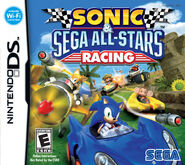No edit summary |
|||
| Line 78: | Line 78: | ||
[[Category:Nintendo systems]] |
[[Category:Nintendo systems]] |
||
[[Category:2004]] |
[[Category:2004]] |
||
| − | [[Category:Handheld |
+ | [[Category:Handheld platforms]] |
Revision as of 03:34, 22 January 2019
Information in this article is about real-life people, companies, and objects, which do not relate to the in-universe Sonic series. |
The Nintendo DS (officially Nintendo Developers' System[7] but can also be called as Nintendo Dual-Screen[7] and abbreviated as NDS) is a handheld game system developed and manufactured by Nintendo. It has two screens; the top screen being for viewing only, while the lower screen can be used as a touchscreen interface.
The first two iterations, the Nintendo DS and DS Lite are also able to play Game Boy Advance titles (which can be displayed on any screen, however the screen it is displayed on must be changed in the Options; by default it is the top screen), of which there are many from the Sonic series. The third and fourth iterations, the Nintendo DSi, and the DSi XL are unable to play Game Boy Advance titles due to the removal of the GBA slot. Its successor is the Nintendo 3DS which had a backward-compatibility with the console.
Sonic the Hedgehog made his debut on the DS with the critically acclaimed Sonic Rush. His final game on the DS was Sonic Colors.
List of Sonic games
- Sonic Rush (2005)
- Sonic Rush Adventure (2007)
- Mario & Sonic at the Olympic Games (2008)
- Sega Superstars Tennis (2008)
- Sonic Chronicles: The Dark Brotherhood (2008)
- Mario & Sonic at the Olympic Winter Games (2009)
- Sonic & Sega All-Stars Racing (2010)
- Sonic Classic Collection (2010)
- Sonic Colors (2010)
Characters introduced
Box artwork gallery
| Gallery |
|---|
References
- ↑ ゲームハードの初期価格 (Japanese). Geocities Japan (11 November 2006). Retrieved on 2 August 2018.
- ↑ Harris, Craig (20 September 2004). Official Nintendo DS Launch Details. IGN. Retrieved on 2 August 2018.
- ↑ CESA staff (July 2016). "11" (in Japanese). CESAゲーム白書. CESA. p. 175. ISBN 978-4902346343.
- ↑ 4.0 4.1 4.2 Consolidated Sales Transition by Region (PDF). Nintendo (27 April 2016). Retrieved on 9 April 2018.
- ↑ Robertson, Andy (18 September 2012). The (Nearly) Definitive Nintendo Battery Test. Wired. Retrieved on 6 March 2018.
- ↑ Sklens, Mike (24 October 2004). Nintendo Tells Players 'Touching is Good'. Retrieved on 20 July 2018.
- ↑ 7.0 7.1 Nintendo . What Does "DS Stand For?. Nintendo Support. Retrieved on 2 August 2018. "To our developers, it stands for "Developers' System," since we believe it gives game creators brand new tools which will lead to more innovative games for the world's players. It can also stand for "Dual Screen.""
Template:Video game systems









